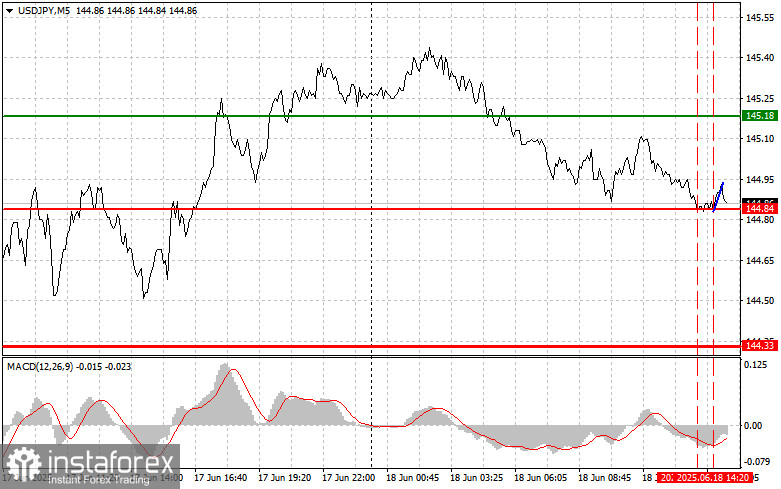Trade Review and Trading Tips for the Japanese Yen
The first test of the 144.84 level in the first half of the day occurred when the MACD indicator had already moved significantly below the zero line, limiting the pair's downward potential. The second test of this price led to the implementation of Scenario #2 for buying. However, as you can see on the chart, the pair did not show any substantial growth afterward.
Today's key focus is the decision by the U.S. Federal Open Market Committee (FOMC) regarding the benchmark interest rate and the accompanying economic outlook. This will be followed by a press conference by Jerome Powell. If the Fed Chair maintains the previous stance, the dollar is likely to weaken and continue declining. However, the accompanying statement—and especially Powell's remarks—may change this impression. If Powell once again confirms the commitment to high interest rates without indicating a forthcoming cut, the dollar is likely to strengthen.
As for the intraday strategy, I will rely primarily on the execution of Scenarios #1 and #2.

Buy Signal
Scenario #1: I plan to buy USD/JPY today at the entry point around 145.02 (green line on the chart) with a target of rising to 145.68 (thicker green line). Around 145.68, I will exit long positions and open short positions in the opposite direction (expecting a 30–35 point pullback from the level). A strong rally today is only likely if the U.S. data are strong. Important: Before buying, make sure that the MACD indicator is above the zero line and just starting to rise from it.
Scenario #2: I also plan to buy USD/JPY if the price tests 144.78 twice consecutively, while the MACD is in the oversold zone. This will limit the pair's downward potential and lead to a market reversal upward. A rise to 145.02 and 145.68 can be expected.
Sell Signal
Scenario #1: I plan to sell USD/JPY today after the level of 144.78 (red line on the chart) is updated, which could trigger a quick drop in the pair. The main target for sellers will be 144.14, where I will exit shorts and immediately open long positions in the opposite direction (expecting a 20–25 point rebound). Selling pressure will return in case of weak U.S. data. Important: Before selling, make sure that the MACD indicator is below the zero line and just starting to decline from it.
Scenario #2: I also plan to sell USD/JPY if the price tests 145.02 twice consecutively, while the MACD is in the overbought zone. This will limit the pair's upward potential and trigger a downward market reversal. A decline to 144.78 and 144.14 can be expected.

What's on the Chart:
- Thin green line – entry price for buying the instrument
- Thick green line – projected level to set Take Profit or manually lock in gains, as further growth above this level is unlikely
- Thin red line – entry price for selling the instrument
- Thick red line – projected level to set Take Profit or manually lock in gains, as further decline below this level is unlikely
- MACD Indicator – use overbought and oversold zones to guide entry decisions
Important: Beginner Forex traders must be very cautious when deciding to enter the market. It's best to stay out before major fundamental reports are released to avoid sudden price swings. If you choose to trade during news events, always set stop-loss orders to minimize losses. Without stop-losses, your entire deposit can be lost quickly, especially if you disregard money management and trade large volumes.
And remember, successful trading requires a clear trading plan, like the one outlined above. Spontaneous decisions based on current market conditions are an inherently losing strategy for intraday traders.





















